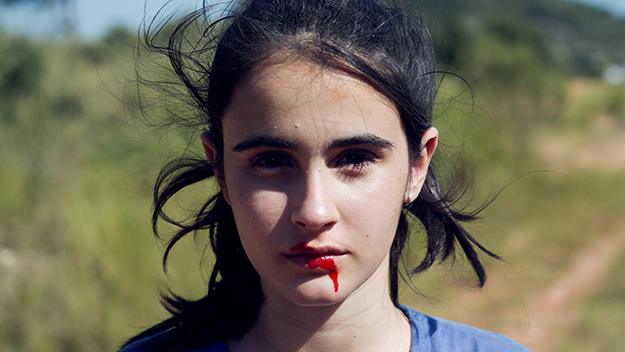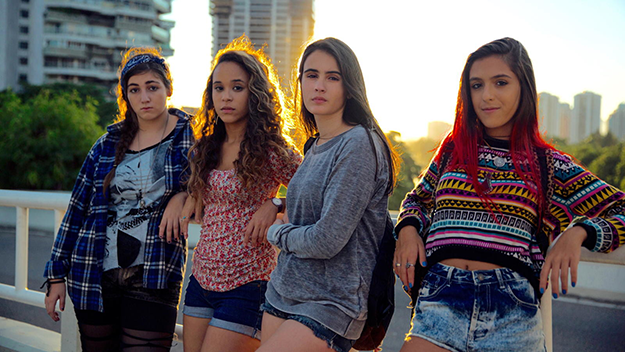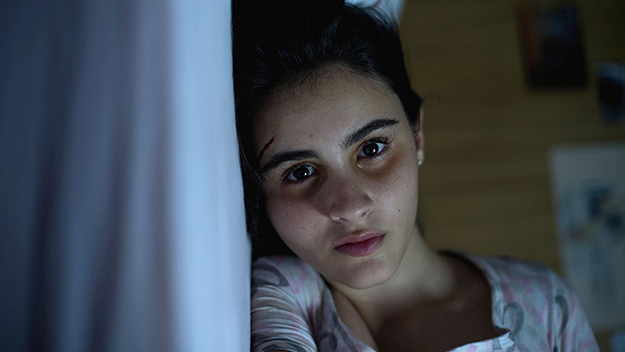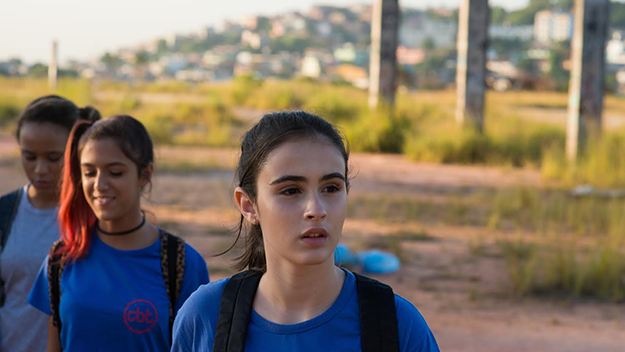The film’s protagonist Bia (Valentina Herszage) is a teenage girl who fits the description of the increasingly long list of female casualties. That level of identification fuels her macabre interest in these sexually violent crimes; she stalks the victims on Facebook, walks at night through the same barren fields where the attacks often take place, and, in one of the film’s most indelible moments, kisses a bloodied victim left for dead who is still fighting for her life. Bia wears her bloodstained lips like a lethal and seductive badge of honor as hints of the supernatural threaten to take over the eerie atmosphere that pervades Silveira’s Barra da Tijuca. Crafting a world without adults (parents and teachers remain curiously off-screen), the Brazilian director plunges her audience into a hormonal world of teenage abandon where the death wish invoked in the film’s title becomes the new norm.
One of the things that I love about Kill Me Please is that it addresses adolescent female desire in a really interesting way. It’s dangerous but fun, alluring but frightening. I made three shorts before, and all of them had young characters. When I went to do my first feature film I wanted to continue exploring this. It’s something I’d been through. So some of these things were inspired by memories from my teenage years. Things I had seen my friends doing. Being from Rio there’s a lot of desire and emotion and I wanted to construct this character, Bia, who somehow goes against morality. She doesn’t care what the Church says, what’s right or wrong. I think she’s somehow inspired by a friend of mine who, when we were 20, committed suicide. She was bipolar. She was diagnosed just a few months before dying and she did everything to extremes. But I think all teenagers have this way of testing themselves to the limit. After my friend’s suicide, I came across this phrase from Georges Bataille that says to be young is to want to die without stopping living. That is, to feel everything extremely. And for me, the film has the energy of death, but not death as the opposite of being alive. Dying is more of a stage of living to the extreme. To go back to the desire, I wanted to construct this character who, while her brother is getting lost in his mind, is not thinking so much. She’s doing whatever she feels like doing. Because she’s 15 years old and full of desires. I watched two of your shorts, Handball [10] and The Living Dead [12], which seem like the seeds of what became Kill Me Please. Why did you decide explore these same themes with the larger canvas of a feature? In 2011, a producer, Vânia Catani, said to me, “I have money for developing scripts and I want to produce yours.” I wasn’t writing this script [at the time], I was writing another feature project that I’d developed for my postgraduate degree. I didn’t like this script so much, and after finishing it, I became interested in continuing Handball. I wanted to get more from its characters, who were really close to me. I grew up playing handball: in Brazilian schools, boys play football [soccer] and girls play handball. I remember friends talking about the pleasure of breaking a nose. I wanted to expand on the images of Handball but I had also just shot The Living Dead in 2011, and its character of the brother spoke loudly to me in terms of social media. I don’t know if you have Brazilian friends on Facebook, but they go crazy: if you don’t reply right away, you’re basically dead. And also, I know a lot of people from my generation who somehow get to their thirties still living with their parents. They don’t work, or just take a job here or there. If they can, they stay on the sofa all day and go to a party at night. And continue doing so until their parents say something. So I wanted to put this type of character in the film. Because it’s my first feature, I think I put a lot of things in it. I have many friends who went to screenwriting labs, with projects that are doing very well. But somehow I think their projects have a format created by these labs. I went to one or two labs, and I heard a lot of criticism: Your project goes all over the place! You can’t define it in any one genre! Is it a coming-of-age film? Is it a horror film? One day I thought, is that a problem? That’s what I want to do, at least for this first film. Maybe for my second one I’ll be more focused, but for my first feature I’ll put myself at risk.
After that first scene following the drunk girl in the dark, we think we know what kind of movie we’re about to watch, but then it becomes this sprawling film that loses interest in revealing who is behind these killings. That’s what makes the final image so powerful. Was that what you always had in mind for the film’s closer? No, the first treatment of this script actually revealed the killer at the end. But then I continued working and I realized that I didn’t want to make that film. I was more interested in showcasing how this killer, or killers, affects the characters. One day I was brainstorming about the film and the image of people waking and walking from this field came to mind. For me, while it was important to say that, yes, Bia is going through this, I also wanted to show that it’s bigger than her. It’s not about one girl. It’s about being young. The script had many stages where it was really different. Remember the story that Michelle, the girl with red hair, tells about an actress who was killed? That is a true story. It’s something that’s really big in Rio, a murder everybody knows about because it was a famous actress. And her mother—I didn’t put this in the film—was the screenwriter of her soap operas. And in Brazil, the screenwriter is much more important than the director. They’re the ones who choose the cast. So her mother picked this guy to be her daughter’s love interest and he turned out to be a psychopath. It all became really crazy, and somehow the project was more inspired by this story, at one point there was even a couple of killers at the end, but then I said, why am I doing that? Just because it happened? It shouldn’t be about that. I want to talk about different things. So I changed it. Could you talk about the macabre stories that the girls share with one another? In my teenage years, these types of urban legends were very common. They tell the Bloody Mary story, which in Brazil is called the Bathroom Blondes—because blonde girls are not so common here, I guess. And, for example, the story in Handball kind of happened to a friend of a friend of a cousin… Everyone loves telling these stories, which sometimes are urban legends and sometimes are something that really happened. But it gets lost in the middle. It could’ve happened; it didn’t happen. I wanted to mix this feeling, because these are stories for girls to learn what they shouldn’t do: I have this friend who went to a party, got drunk, and then got raped. So it’s about morality, about what girls have to live and learn. I wanted to put in the film that fear that girls grow up with.
I read that Brian De Palma’s Carrie and Sofia Coppola’s The Virgin Suicides are two of a handful of influences on this film. What did you draw from them? The main influence for me was David Lynch’s Twin Peaks. Mostly because I faced this neighborhood [in the spirit of how Lynch approached] Twin Peaks. Because I shot everything in Barra da Tijuca and I think of this Rio de Janeiro neighborhood as [this sort of] alternative universe. Lynch is an influence also for the way he moves between humor and something much darker—his suspense. Besides De Palma and Coppola, I’ve been influenced by Tsai Ming-liang and a little bit by Claire Denis. I think Trouble Every Day is a great film about desire. And for creating Bia, I looked to Maurice Pialat’s À Nos Amours. I liked that the Sandrine Bonnaire character had sex with everyone. And there’s a scene that obviously owes a big influence to Mean Girls. There’s a Regina George–like character. This idea of switching tones comes through with the music, too, especially during that character’s birthday party. This kind of birthday party, the quinceañera, is very common in Brazil. Turning 15 there is like the Sweet Sixteen. Even a poor family gets the money to pay for the celebration. In the beginning, I wrote the party with some dialogue, but then I figured we could convey everything without dialogue. The party is almost like a short film. It’s like a music-video clip.
What did you look for in your actors? There’s a subtlety and naturalism across the board, but especially in Valentina Herszage, who plays Bia. For me, it was very important to have actors the same age as the characters. In Rio we have Globo, a big television company, and there are lots of teenagers who dream of being actors. I announced the casting call at drama schools and on Facebook, and I received like 500 e-mails from girls. After dismissing a few who said they were 25 but promised they looked 15—I didn’t want that—I called in 200 for a first test, and of them I picked 15. It was almost like a test for American Idol. For me, 80 percent was choosing the right cast—to find girls with the right sensibility. And then after making the final selection, the first thing I did was play films for them because most were used to watching soap operas. And Glee. I showed them The Virgin Suicides, Paranoid Park, and others that feature more natural acting. We rehearsed a lot, but most of it was getting them to see a lot of films. Just to get them to think of performance differently—to open their eyes to this other kind of acting.



